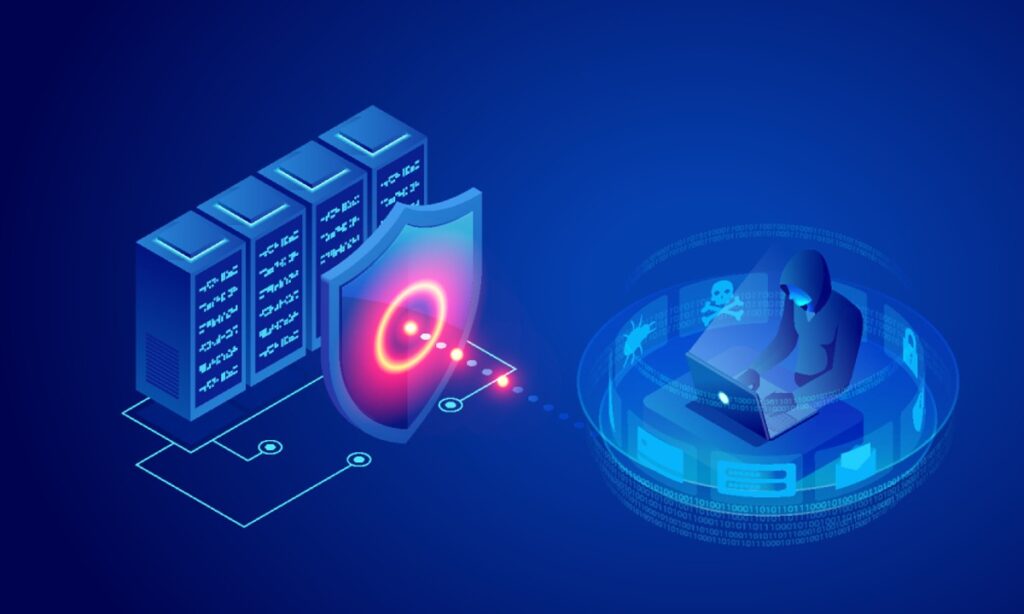Understanding Distributed Denial-of-Service (DDoS) Attacks

Your website keeps crashing and you can’t figure out why. DDoS might be the problem. This post will show you what these attacks are, how they work, and ways to stop them. Keep reading for solutions.
What is a DDoS Attack?
A DDoS attack involves flooding a target system or network with an overwhelming amount of traffic, rendering it inaccessible to legitimate users. This type of cyber attack disrupts the normal functioning of online devices and critical infrastructure.
Definition and Overview

A DDoS (Distributed Denial-of-Service) attack is a major threat to internet security. It aims to make a targeted server, service, or network unavailable by flooding it with overwhelming amounts of traffic.
This cyberattack uses many hacked computers and Internet of Things (IoT) devices to create this flood. These machines could be anything from personal computers to various online gadgets.
Moving on, we’ll explore the key differences between DoS and DDoS attacks.
Key Differences Between DoS and DDoS
Understanding the differences between DoS and DDoS attacks is essential. Here we break down these differences in a straightforward table.
| Aspect | DoS (Denial of Service) | DDoS (Distributed Denial of Service) |
|---|---|---|
| Source | Single source | Multiple sources |
| Devices Involved | One attacking device | Many devices, often part of a botnet |
| Difficulty to Mitigate | Less challenging | More challenging due to distributed nature |
| Identification | Easier to trace | Harder to distinguish from normal traffic |
| Objective | Disrupt service | Disrupt service |
Both DoS and DDoS aim to disrupt service availability. However, the use of multiple sources in DDoS attacks makes them particularly difficult to mitigate. Each bot involved in a DDoS attack is a legitimate Internet device, further complicating the distinction between attack traffic and normal traffic.
How DDoS Attacks Work
Hackers launch DDoS attacks by overwhelming a network, server, or website with a flood of traffic, rendering it inaccessible to legitimate users. The attackers utilize botnets and various techniques to amplify the volume of malicious traffic directed at the targeted system.
The Role of Botnets
Botnets play a crucial part in the execution of DDoS attacks. These networks consist of machines infected with malware, enabling cyber attackers to control them remotely. Each machine, known as a bot or zombie, joins together to form a botnet.
Cyber attackers send commands to these bots, directing them to flood a target’s IP address with requests. This can overwhelm servers and lead to server overload.
The power behind DDoS attacks lies in this collective force of compromised internet-connected devices. By utilizing botnets, cybercriminals can amplify their attack capacity without needing vast physical resources themselves.
This cybersecurity threat shows the destructive potential when multiple infected devices act together following an attacker’s instructions.
Common Attack Techniques

DDoS attacks employ various common attack techniques, aiming to disrupt network services and cause denial of service. Here are the key tactics utilized:
- Volumetric Attacks: These floods networks with a high volume of traffic, overwhelming the bandwidth capacity.
- Protocol Attacks: Exploiting weaknesses in networking protocols, such as SYN Floods that flood servers with initial connection requests.
- Application Layer Attacks: Targeting specific applications or servers, for instance, HTTP Floods inundate web servers with HTTP GET requests.
These techniques illustrate the diverse methods used in DDoS attacks to compromise network security and inflict disruption on targeted systems.
Types of DDoS Attacks
DDoS attacks come in various forms, including volumetric attacks, protocol attacks, and application layer attacks. These different methods can overwhelm network resources and disrupt the availability of targeted systems.
Volumetric Attacks
Volumetric attacks are a type of DDoS attack that overwhelms a targeted system by flooding it with an immense volume of traffic, causing network congestion and disrupting legitimate access.
These attacks create a massive influx of data, saturating the target’s internet bandwidth and rendering it unable to handle normal requests. For instance, in a DNS amplification attack, spoofed DNS requests are used to amplify the amount of traffic sent to the victim’s server, exacerbating the impact.
Another example is UDP flood attacks where User Datagram Protocol (UDP) packets flood the target’s ports, consuming resources and leading to service degradation or downtime. Volumetric attacks exploit security vulnerabilities within network infrastructure by inundating them with malicious traffic.
These types of attacks can be debilitating for businesses and organizations reliant on online operations.
Protocol Attacks
Volumetric attacks focus on overwhelming network bandwidth, while protocol attacks, known as state-exhaustion attacks, target the weaknesses in layers 3 and 4. By exploiting vulnerabilities in network protocols like TCP/IP or ICMP, these attacks disrupt communication between devices by consuming all available resources.
For instance, a classic example is the TCP SYN flooding attack which inundates a server with connection requests containing fake IP addresses, rendering it unable to handle legitimate connections effectively.
This form of cyber assault can lead to severe service disruption and system instability.
Application Layer Attacks
Application layer attacks specifically target the layer responsible for generating web pages on the server. An example of such an attack is the HTTP Flood, characterized by multiple HTTP GET requests.
These attacks overwhelm the application layer and exhaust server resources. Another type of application layer attack is the low and slow attack, which gradually consumes server resources over time, making it challenging to detect as it resembles normal traffic patterns.
These attacks have the potential to disrupt web servers, leading to downtime and negatively impacting user experience.
These intricate attacks necessitate strong defense mechanisms to prevent disruption. Application front-end hardware can aid in mitigating these attacks by filtering out malicious traffic at the network edge before it reaches the application layer.
Furthermore, implementing advanced DDoS protection solutions such as integrated defense systems and cloud-based protection services can offer comprehensive defense against application layer attacks.
Recognizing DDoS Attack Symptoms

To identify DDoS attack symptoms, monitor for unusual spikes in internet traffic or server slowdowns. Look out for frequent network disconnections or unexplained service disruptions that could indicate a potential DDoS attack.
Common Indicators of an Attack
- Sudden slowdown or unavailability of a website or service may indicate a DDoS attack.
- Suspicious amounts of traffic from a single IP address or range could be a sign of an ongoing attack.
- A surge of traffic from users sharing a behavioral profile might be an indication of a potential DDoS attack.
- Unexplained spikes in requests to a specific page or endpoint might indicate malicious activity.
- Odd traffic patterns, such as spikes at unusual hours, may be an indicator of a DDoS attack.
- Unusual website behavior, such as error messages or slow loading times, may signify an ongoing attack.
- Abnormal traffic patterns, including unusually high volumes of incoming traffic, are often associated with DDoS attacks.
- Anomalous web traffic, where the nature and volume differ significantly from typical patterns, indicates a potential DDoS attack threat.
- Indications of a DDoS attack may also include unexplained network slowdowns affecting various services and resources.
- Suspicious IP address activity, especially when originating from unfamiliar sources, might raise concerns about the possibility of a DDoS attack impacting the network and its assets.
- Irregular web traffic spikes showing significant deviations from normal visitor behavior may indicate an ongoing DDoS attack that needs immediate attention.
Distinguishing Between High Traffic and DDoS
Distinguishing between high traffic and DDoS involves analyzing network behavior for unusual patterns. High traffic typically originates from various sources, while DDoS attacks may exhibit coordinated spikes or distinctive traffic patterns.
To discern between the two, monitoring tools can be utilized to detect abnormal network behavior and identify potential signs of a DDoS attack. By observing the behavioral profiles of network traffic, it becomes possible to differentiate between regular high traffic scenarios and malicious DDoS activities.
The distinction is further complicated by the fact that each bot involved in a DDoS attack leverages legitimate Internet-connected devices. Therefore, identifying these subtle differences in network congestion and traffic characteristics becomes crucial in effectively recognizing and mitigating potential DDoS threats.
DDoS Attack Tools and Techniques
DDoS attackers utilize various amplification techniques, exploit vulnerable ports, and deploy botnets such as Mirai to launch coordinated attacks. They employ these tools and methods to overwhelm network resources and disrupt online services.
Amplification Techniques
Amplification techniques are commonly used in DDoS attacks to increase the volume of traffic sent to the target network. These techniques exploit vulnerable services and protocols to amplify the size of attack packets, overwhelming the target’s resources. Here’s a detailed look at how amplification techniques are leveraged in DDoS attacks:
- DNS Amplification Attack: This technique involves sending a small DNS query with a forged source address to open DNS resolvers, which then respond with a large amount of data to the victim’s IP address.
- NTP Amplification Attack: In this method, attackers send small queries to Network Time Protocol (NTP) servers that will respond with a much larger packet, causing amplification of attack traffic towards the target.
- SSDP Attack: Using Simple Service Discovery Protocol (SSDP), attackers can craft and send requests that result in larger responses being sent to the victim.
These amplification techniques enable attackers to generate massive volumes of traffic while concealing their original source, making it challenging for targets to defend against such attacks effectively.
Exploiting Vulnerable Ports
Exploiting vulnerable ports is a common technique in DDoS attacks and can significantly impact network security. Here are some methods utilized for exploiting vulnerable ports:
- Port scanning: Attackers use automated tools to scan for open ports on target systems, seeking vulnerabilities to exploit.
- Network vulnerability: Exploiting known weaknesses in network infrastructure, such as unpatched or outdated software, allows attackers to gain unauthorized access.
- Penetration testing: By simulating an attack, organizations can identify and address potential vulnerabilities before malicious actors exploit them.
- Firewall protection: Implementing robust firewall rules and configurations helps defend against port exploitation by restricting unauthorized access to vulnerable services.
- Malicious traffic: Attackers flood specific ports with high volumes of illegitimate traffic to overwhelm targeted systems, rendering them inaccessible.
- Cyber attacks: Exploiting vulnerable ports enables cybercriminals to launch various types of attacks, compromising the integrity and availability of network resources.
- Exploitation techniques: Attackers leverage diverse methods such as buffer overflow exploits, SQL injection, or remote code execution to compromise vulnerable ports.
- Denial of Service: Vulnerable ports can be exploited to execute denial-of-service attacks aimed at disrupting legitimate network communications and services.
Usage of Mirai and Other Botnets
Exploiting vulnerable ports can result in the activation of well-known botnets such as Mirai, which has been linked to several high-profile DDoS attacks. The Mirai botnet, infamous for using Internet of Things (IoT) devices like routers and digital cameras, caused significant disruption in internet services globally.
This underscores the concerning potential of IoT devices being manipulated by malicious actors to carry out large-scale DDoS attacks.
The use of botnets to target vulnerable devices presents a significant cybersecurity risk, adding to the challenges encountered in defending against cyber attacks. For example, the Memcached DDoS attack illustrated how cybercriminal strategies have advanced to exploit weaknesses in network security through the use of sophisticated malicious software like Mirai and other powerful botnets.
Impact of DDoS Attacks
DDoS attacks can severely disrupt business operations and cause network performance to falter, ultimately affecting the availability of targeted systems. To delve deeper into this topic, read on.
On Business Operations
DDoS attacks can significantly disrupt business operations, causing extended downtime that impacts revenue and customer confidence. A notable example occurred on August 8, 2024, when a massive DDoS attack delayed an interview between Donald Trump and Elon Musk.

Such interruptions in service availability not only harm the company’s reputation but also potentially lead to customer dissatisfaction and loss of confidence in online security measures.
These cyberattacks can have severe consequences for businesses, resulting in significant financial losses due to service disruptions. It is crucial for companies to implement strong cybersecurity measures to protect their networks from such malicious traffic and potential data breaches.
Now, moving on to the impact of DDoS attacks on network performance….
On Network Performance
DDoS attacks can have a significant impact on network performance. The overwhelming of server capacity by malicious traffic renders systems unavailable, causing congestion that reduces overall network efficiency.
This disrupts ongoing operations and can lead to long-term damage to the infrastructure.
To counteract the effects of DDoS attacks and maintain optimal network performance, it is crucial for organizations to implement strong mitigation strategies such as traffic filtering, denial of service prevention measures, intrusion detection systems, vulnerability assessments, and resilience planning.
These proactive steps are essential in safeguarding against potential disruptions caused by DDoS attacks and ensuring smooth network functionality.
DDoS Mitigation Strategies
Implementing Blackhole Routing, Rate Limiting, and Application Front-End Hardware can bolster defenses against DDoS attacks. To read more, visit the full article on Understanding Distributed Denial-of-Service (DDoS) Attacks.
Blackhole Routing
Blackhole routing is a method utilized in DDoS attack mitigation strategies. It entails redirecting malicious and legitimate traffic towards a null route, effectively discarding all incoming traffic.
This technique aids in managing network congestion and defending against denial-of-service attacks.
This method of traffic filtering guarantees that detrimental traffic does not reach its intended destination, thereby shielding the target from cyber threats. Blackhole routing is vital for internet traffic management and plays a key role in maintaining network security by efficiently handling malicious traffic.
Rate Limiting
Rate limiting is a crucial DDoS mitigation strategy that regulates the number of requests a server accepts within a specified time frame. This approach aids in mitigating the impact of high-volume attacks by managing traffic flow through methods like traffic shaping, throttling, and bandwidth management.
By integrating request rate control and network congestion management, rate limiting ensures prioritization of legitimate user requests while confining malicious traffic. This contributes to the preservation of application performance and network security.
Moreover, it encompasses load balancing to equitably distribute incoming requests across multiple servers, preventing overload on any single server. Rate limiting plays a vital role in alleviating network congestion during DDoS attacks and is a fundamental element of scalable solutions for robust defense against such threats.
Application Front-End Hardware
Front-end hardware, such as web application firewalls (WAF) and traffic filtering devices, plays a crucial role in mitigating DDoS attacks. WAFs act as reverse proxies, effectively screening out malicious traffic before it reaches the server.
These measures help safeguard against various attack techniques and ensure the protection of network infrastructure.
Rate limiting and filtering hardware can be installed at the server entry point, enhancing security by managing incoming traffic and preventing overwhelming requests that could lead to a successful DDoS attack.
Such proactive strategies are vital components in strengthening cyber defenses against evolving threats.
Moving forward to discuss “Advanced DDoS Protection Solutions,” let’s explore more sophisticated defense mechanisms essential for combating modern-day cyber attacks.
Advanced DDoS Protection Solutions
Implementing upstream filtering, integrating defense systems, and utilizing cloud-based protection services are effective approaches for advanced DDoS protection. They employ cutting-edge technology to safeguard network resources from malicious attempts and ensure the availability of critical infrastructure.
Upstream Filtering
Upstream filtering is an advanced DDoS protection solution that operates at the ISP level, actively filtering traffic before it reaches its intended destination. By proactively intercepting and analyzing incoming traffic, this approach enables early threat detection and mitigation, helping to safeguard against targeted attacks.
Such proactive measures allow for a more robust defense against potential threats and ensure a higher level of internet service provider security.
This upstream traffic filtering technology plays a crucial role in preventing disruptions caused by DDoS attacks while offering a proactive threat response system. Its early threat detection capabilities make it an integral part of advanced cyber security, providing efficient traffic filtering solutions to mitigate potential risks on both network performance and business operations.
With these benefits in mind, upstream filtering proves to be an essential part of any comprehensive DDoS protection strategy.
Integrated Defense Systems
Integrated Defense Systems encompass various defense strategies, including network security, threat detection, and intrusion prevention, to provide comprehensive protection against DDoS attacks.
This approach leverages a mix of hardware, software, and cloud solutions for effective attack mitigation and malware protection. These systems also include traffic filtering, firewall solutions, and vulnerability management to safeguard networks from evolving cyber threats.
By integrating these advanced DDoS protection solutions, businesses can strengthen their security protocols and mitigate the impact of potential attacks.
These systems are crafted to improve cybersecurity by harnessing a combination of cutting-edge technologies such as upstream filtering and cloud-based protection services. The seamless integration of these tools helps fortify network defenses against malicious activities while adapting to the ever-evolving landscape of cyber threats.
Integrated Defense Systems not only provide strong defense mechanisms but also ensure optimal network performance through careful traffic management and sophisticated attack detection capabilities.
Cloud-Based Protection Services
Cloud-based protection services offer advanced DDoS mitigation and cybersecurity solutions. These scalable security measures provide online attack prevention and threat detection with internet traffic management.
For instance, Cloudflare operates a 296 Tbps network, significantly larger than the largest recorded DDoS attack, ensuring strong network protection. In addition, these cloud-based defense mechanisms are integrated to provide web security services for businesses facing cyber threats.
These cloudbased security services also encompass upstream filtering and multidimensional defense systems for effective threat detection and response. They emphasize their capability to manage the constantly evolving realm of cybersecurity through tailored cloud-based protections designed to improve network resilience.
Legal and Ethical Considerations
Legal and ethical considerations surrounding DDoS attacks include the legality of such actions and the ethical implications on public perception. Exploring these aspects provides valuable insights into the broader impact of cyber threats and attack mitigation strategies.
Legality of DDoS Attacks
DDoS attacks are illegal and fall under cybercrime laws. Perpetrators who launch DDoS attacks can face severe legal consequences, including criminal charges and potential imprisonment.
Law enforcement agencies globally have been actively enforcing cybersecurity measures to combat these illegal activities, emphasizing the seriousness of such offenses. The legal implications surrounding DDoS attacks underscore the need for robust defense mechanisms and stringent regulations to address cyber threats effectively.
Furthermore, ethical concerns related to DDoS attacks are paramount in shaping public perception. Understanding the ethical implications is crucial as these attacks disrupt vital online services and impact innocent users.
As a result, addressing both the legality and ethical considerations is essential in combating cybercrimes effectively. These multifaceted issues highlight the significance of upholding cybersecurity laws and implementing stringent measures to deter perpetrators from engaging in unlawful cyber activities.
Future Trends in DDoS Attacks and Defense
Ethical Implications and Public Perception
Public perception of DDoS attacks tends to be largely unfavorable, with these attacks often seen as disruptive and harmful to both individuals and businesses. The ethical considerations regarding DDoS attacks revolve around the misuse of compromised devices to carry out such acts.
When it comes to public perception, it’s important to recognize that these attacks can cause significant disruption and damage, impacting not only the targeted organizations but also their customers or users.
Ethically, the use of compromised devices in DDoS attacks raises concerns about privacy violations and potential harm caused by unauthorized access to these devices. Furthermore, the widespread availability of tools and techniques for executing DDoS attacks draws attention to the need for stricter regulations on cybersecurity practices.
Additionally, there is a growing emphasis on digital ethics and online safety within the information security domain amid rising concerns over cybercrime.
Future Trends in DDoS Attacks and Defense
As DDoS attacks continue to evolve, it’s crucial to stay ahead of emerging attack vectors and advancements in AI and machine learning for defense. Understanding the evolving landscape of DDoS threats and defenses is essential for organizations to proactively adapt their security measures.
Evolving Attack Vectors
As attackers continue to develop more advanced methods and target IoT devices, the realm of cyber threats is undergoing significant changes. The shifting tactics in cyber attacks demand more robust defense measures to combat these increasingly sophisticated threats effectively.
Advances in AI and Machine Learning in Defense
AI and machine learning play crucial roles in defense against DDoS attacks. These technologies enable early threat detection and response through predictive analytics, enhancing cybersecurity measures.
Autonomous defense systems powered by AI can adapt rapidly to evolving threats, bolstering network security with advanced threat detection and swift mitigation of cyber attacks. Furthermore, these solutions provide essential threat intelligence, aiding in the proactive development of security protocols to counter emerging attack vectors.
Incorporating AI and machine learning not only enhances malware detection but also facilitates cloud-based protection services aimed at improving overall cybersecurity. Such advanced technologies are instrumental for organizations facing the constantly changing realm of cyber threats, offering customized defenses against prominent dangers in the world of network security.
With AI’s capabilities for adaptive defense mechanisms and predictive analysis, the integration of these cutting-edge tools into defense strategies is recommended for effectively addressing the challenges posed by modern-day cyber threats.
Conclusion
DDoS attacks are a serious threat to online security and network performance. Understanding their techniques, impact, and mitigation strategies is crucial in safeguarding against potential disruptions.
With the growing complexity of cyber threats, staying vigilant and implementing robust defense measures is essential for protecting critical infrastructure and maintaining reliable online services.
As technology continues to advance, ongoing efforts in cybersecurity will be vital in combating evolving attack vectors and ensuring the availability of internet resources for legitimate users.
FAQs
1. What is a Distributed Denial-of-Service (DDoS) attack?
A DDoS attack is when multiple computers overwhelm a server or network with traffic. This flood of requests makes the service unavailable to users.
2. How do DDoS attacks work?
DDoS attacks use many compromised devices, known as bots, to send excessive requests to a target. The goal is to exhaust resources and disrupt normal operations.
3. What are the effects of a DDoS attack on businesses?
Businesses may experience downtime during an attack. This can lead to lost revenue, damaged reputation, and increased recovery costs due to interrupted services.
4. How can organizations protect against DDoS attacks?
Organizations can implement security measures like firewalls and traffic filtering systems. Regular monitoring and having an incident response plan also help mitigate risks from potential attacks.









